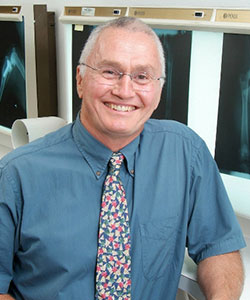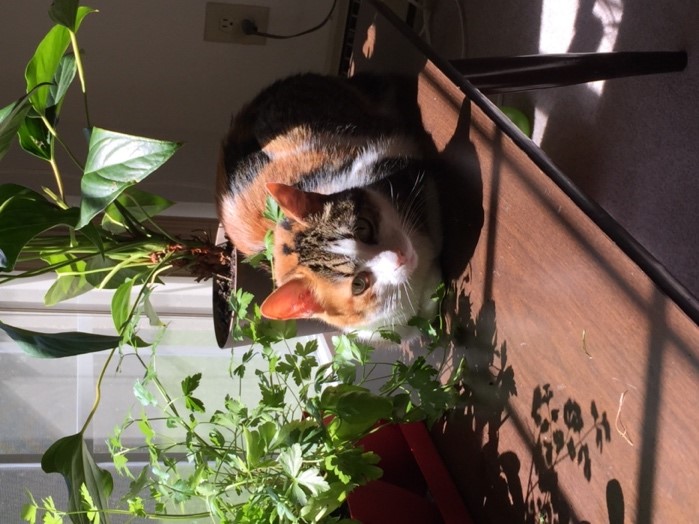Improving the health and well-being of cats through research
Genomic study brings us a step closer to understanding some of the most common feline diseases
Each year, owners of the many cats diagnosed with hyperthyroidism and diabetes seek help from the Cornell University Hospital for Animals (CUHA). Despite the high prevalence of these diseases, scientists still don't know which genes contribute to these and other common feline ailments. This roadblock prevents the development of more effective treatments and diagnostic tests for our feline friends.

To begin to correct this problem, a wide-reaching collaboration led by Dr. Rory Todhunter, B.V.Sc., Ph.D. '92, professor of surgery in the Department of Clinical Sciences at the College of Veterinary Medicine, identified regions of the cat genome associated with nine of the most common and perplexing conditions affecting cats. With support from the Cornell Feline Health Center (CFHC), experts at the Cornell Veterinary Biobank (CVB) and faculty at CUHA and other institutions discovered regions linked to hyperthyroidism, diabetes and a common eye condition called feline eosinophilic keratoconjunctivitis (FEK). Their research is the largest genomic study of complex feline diseases in non-purebred cats to date.
The study is the first step toward identifying the genetic mechanisms of these diseases. This new understanding holds the promise of novel treatments, better diagnostic tests, and improved means of disease prevention. Such advances will likely lead to better outcomes in cats suffering from these diseases and improved breeding practices, both of which can lead to a healthier feline population.
"This is a cutting-edge study with respect to the technology, the quality of the screening and the size of the cohort," said Dr. Bruce Kornreich, D.V.M. ‘92, Ph.D. ‘05, director of the Cornell Feline Health Center. "These are some of the most important feline diseases in clinical veterinary practice, and determining their genetic basis has tremendous potential for the future of feline wellness."
Not Just Purebreds
The nine diseases selected for the study were hypertrophic cardiomyopathy, hyperthyroidism, diabetes mellitus, chronic kidney disease, chronic enteropathy, inflammatory bowel disease, small cell alimentary lymphoma, hypercalcemia, and FEK. These are all complex diseases, meaning they likely result from the interaction of multiple genes and environmental factors.
Unlike many similar studies that focus on purebred cats, this study primarily included random-bred cats — mostly domestic shorthaired ones. This makes the results more widely applicable since more than 90% of cats in the U.S. are random-bred.
"Domestic short, medium, and long-haired cats are those most commonly loved in American households," said Todhunter. "Initially, we had no idea if complex diseases of domestic mixed breed or hybrid cats could even be mapped genetically — we were lucky."

Credit: Courtesy of Isabel Hernadez
The study's cats included dozens of healthy, older cats generously volunteered by their owners to serve as controls. With funding from the Feline Health Center, Dr. Isabel Hernandez, DVM, an instructor and veterinarian at the Small Animal Community Practice, recruited and evaluated the older cats, performed bloodwork and collected a blood sample to be processed into DNA. In an amazing feat of logistical coordination, she shepherded each cat through a series of visits at CUHA specialty services, including dentistry, cardiology, ophthalmology, oncology, nutrition and orthopedics, during which experts examined the cats to rule out each of the nine diseases.
Hernandez even enrolled her own 15-year-old cat, Kippy, in the study. Unfortunately, a CT scan performed during the evaluation revealed a mass in her lungs that took her life just three months later. "I was grateful to know the reason why she was declining, thanks to this screening," she said.
Banking on the Power of Genetics
Hernandez then combed through the extensive records from these cats and others that had submitted samples to the Cornell Veterinary Biobank to categorize them as affected or unaffected for each condition, ultimately selecting 1,122 cats in total. "I spent a lot of time going through records," Hernandez said, "but that's one of the strengths of the study — the high-quality characterization of the study population."
The project would not have been possible without the Cornell Veterinary Biobank, which has collected, processed, stored and distributed feline samples for 15 years under the leadership of its director, Dr. Marta Castelhano, DVM, MVSc. Established in 2006 by Todhunter and consistently supported by the Feline Health Center, the Biobank was the first to receive accreditation to an International Organization for Standardization (ISO) biobanking standard in 2019 due to its commitment to the quality, traceability and integrity of its samples. To date, the CVB has received more than 34,000 DNA samples and 10,900 tissues samples — about 9% and 15%, respectively, from cats.
"We greatly value our partnership with the Cornell Feline Health Center because we have a shared vision, which is to improve the lives of cats," said Castelhano. "We hope our feline participants can help not just other cats but also their human companions."
Genetics: The Future of Medicine
The Cornell researchers teamed up with Dr. Jeff Brockman, PhD, a genomics researcher at Hill's Pet Nutrition in Maryland, to test the DNA from each cat's blood sample. Hill's donated their custom-designed feline mapping array, which detects single variations in the genetic code at 340,000 sites across the cat genome. This array represents a tremendous improvement over the current commercial feline array, which includes 63,000 sites.
Dr. Jess Hayward, PhD, a member of the Biobank statistics team and research associate in Biomedical Sciences, used data from the arrays to perform a genome-wide association study (GWAS). By comparing the DNA from healthy and diseased cats, she could locate the parts of the chromosomes with variations associated with each disease. For six of the nine diseases studied, strong associations were not identified, but the GWAS yielded promising results for hyperthyroidism, diabetes and FEK. While this type of analysis doesn’t reveal exactly which genes are involved, it very importantly allows researchers to narrow in on the right “genetic regions” in future studies.
Now researchers can search for genetic variants in these regions to pinpoint mutations related to each disease, with the goal of piecing together its molecular mechanism. Once these mechanisms are identified, the potential for improvements in disease diagnosis, treatment, and prevention is extremely high.
These findings may also guide research into the human forms of these diseases. "Most of these diseases have parallels in humans, so while we're not necessarily looking at the exact same variant in each case, we're thinking about the same or similar pathways that may be involved," Hayward said.
The hope is that this type of research will one day enable veterinarians to help prevent the underlying causes of diseases rather than merely treating their symptoms. Kornreich believes that in 50 to 100 years, we'll look back on this era of veterinary (and human) medicine in the same way that we currently look at Civil War surgery — necessary but primitive. "The future of medicine is understanding the genetic mechanisms of disease," he said. "By fixing these mechanisms at the genetic and molecular levels, there is tremendous potential to improve the wellbeing of all cats and of those who love them."
Written by Patricia Waldron




